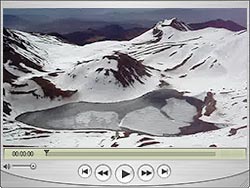Volcano Types
There are many different types of volcanoes. Some form tall mountains, while others are part of large plains.
Mountainous Volcanoes
The structures that rise from the ground fall into a few basic categories.
The stratovolcano, also called a composite cone, is the type of volcano that usually comes to mind when someone says “volcano.” It’s the classic, cone-shaped mountain with a crater on top. Mount Etna in Italy, Mount St. Helens in the United States, Mount Cotopaxi in Ecuador, Mount Fuji in Japan, Mount Pinatubo in the Philippines, and (before it blew itself up) Krakatau in Indonesia are a few examples. The crater can be either a caldera or a hole blasted out during a violent eruption.
 photo courtesy of volunteer David The North Island of New Zealand has many volcanoes. Mount Ngauruhoe, in the foreground, is a classic cone-shaped peak. It last erupted in 1977. Mount Ruapehu, snow-capped in the background, is one of the most active volcanoes in the world. It last erupted in 2007. Ruapehu has two active ski areas on its slopes; skiers are warned that if an eruption occurs they should ski down fast! |
|
PRempel. |
Stratovolcanoes tend to form on coastal land and islands at subduction zones (where continental crust is riding over oceanic crust). These volcanoes don’t erupt that often, but their eruptions are often violent. Strato- means “layer” and refers to the layers of ejected material that blanket the slopes after each blast—lava flows and an assortment of pyroclastic (“broken fire”) debris from fine ash to large rocks. Over time, the layers build up into a steep cone in part because the lava is andesite or dactite, which is viscous—stiff like cookie dough. Viscosity is a measure of the resistance to flowing, and so viscous lava doesn’t travel far. Also, the heaviest debris falls close to the vent.
Another type of mountainous volcano is the shield volcano. An example is Hawaii’s Mauna Loa. These volcanoes are the largest ones on Earth, but they don’t look like it. Instead of being tall, steep, and jagged, these monsters resemble a gently rounded warrior’s shield, laid to rest outer-side-up. The low, wide slopes are deceptive. Beneath them lies a towering mass of lava rock that rises higher off the ocean floor than most land-bound mountains. Shield volcanoes are low and wide because their lava is runny like honey—less viscous than a stratovolcano’s—and so travels fast and far from the vents. Also, because the eruptions are more effusive than explosive, the blast doesn’t shatter the liquid lava to ashy or rocky bits. Shield volcanoes grow to mammoth size due to frequent eruptions of lava over long periods of time. Cinder cones, also called scoria cones, are a third type of mountainous volcano. These common, small volcanoes are steep, often near-perfect cones with relatively large and very round, bowl-shaped craters on top. Their tidy cone shape is in part the result of uniform ejection material. The explosion breaks liquid lava into little drops that sometimes shoot up from the vent like sparks in a fountain—called a Strombolian eruption. The small drops cool quickly in midair and form glassy, bubble-filled bits of tephra (airborne pyroclastic debris) that rain down in a circle around the vent. The tephra is classified by size and includes cinders, the volcano’s namesake. Cinder cones can grow in calderas or on the flanks of larger volcanoes. Hawaii’s shield volcanoes support nearly 100 of these small volcanoes. Cinder cones can also appear, seemingly out of the blue, in volcanic fields, where vents are spread over great distances and give rise to a variety of volcanic forms.
Some volcanoes are incognito—too hidden or too big to see. |
|||||||||||||||||||||
This content has been re-published with permission from SEED. Copyright © 2025 Schlumberger Excellence in Education Development (SEED), Inc.









